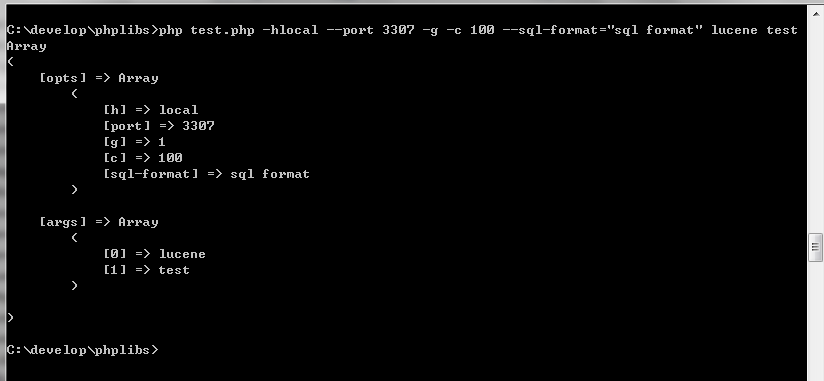PHP 命令列引數解析工具類
<?php /** * 命令列引數解析工具類 * @author guolinchao * @email [email protected] */ class CommandLine { // store options private static $optsArr = []; // store args private static $argsArr = []; // 是否解析過 private static $isParse = false; public function __construct() { if(!self::$isParse) { self::parseArgs(); } } /** * 獲取選項值 * @param string|NULL $opt * @return array|string|NULL */ public function getOptVal($opt = NULL) { if(is_null($opt)) { return self::$optsArr; } else if(isset(self::$optsArr[$opt])) { return self::$optsArr[$opt]; } return null; } /** * 獲取命令列引數值 * @param integer|NULL $index * @return array|string|NULL */ public function getArgVal($index = NULL) { if(is_null($index)) { return self::$argsArr; } else if(isset(self::$argsArr[$index])) { return self::$argsArr[$index]; } return null; } /** * 註冊選項對應的回撥處理函式, $callback 應該有一個引數, 用於接收選項值 * @param string $opt * @param callable $callback 回撥函式 * @throws InvalidArgumentException */ public function option($opt, callable $callback) { // check if(!is_callable($callback)) { throw new InvalidArgumentException(sprintf('Not a valid callback <%s>.', $callback)); } if(isset(self::$optsArr[$opt])) { call_user_func($callback, self::$optsArr[$opt]); } else { throw new InvalidArgumentException(sprintf('Unknown option <%s>.', $opt)); } } /** * 是否是 -s 形式的短選項 * @param string $opt * @return string|boolean 返回短選項名 */ public static function isShortOptions($opt) { if(preg_match('/^\-([a-zA-Z0-9])$/', $opt, $matchs)) { return $matchs[1]; } return false; } /** * 是否是 -svalue 形式的短選項 * @param string $opt * @return array|boolean 返回短選項名以及選項值 */ public static function isShortOptionsWithValue($opt) { if(preg_match('/^\-([a-zA-Z0-9])(\S+)$/', $opt, $matchs)) { return [$matchs[1], $matchs[2]]; } return false; } /** * 是否是 --longopts 形式的長選項 * @param string $opt * @return string|boolean 返回長選項名 */ public static function isLongOptions($opt) { if(preg_match('/^\-\-([a-zA-Z0-9\-_]{2,})$/', $opt, $matchs)) { return $matchs[1]; } return false; } /** * 是否是 --longopts=value 形式的長選項 * @param string $opt * @return array|boolean 返回長選項名及選項值 */ public static function isLongOptionsWithValue($opt) { if(preg_match('/^\-\-([a-zA-Z0-9\-_]{2,})(?:\=(.*?))$/', $opt, $matchs)) { return [$matchs[1], $matchs[2]]; } return false; } /** * 是否是命令列引數 * @param string $value * @return boolean */ public static function isArg($value) { return ! preg_match('/^\-/', $value); } /** * 解析命令列引數 * @return array ['opts'=>[], 'args'=>[]] */ public final static function parseArgs() { global $argv; if(!self::$isParse) { // index start from one $index = 1; $length = count($argv); while($index < $length) { // current value $curVal = $argv[$index]; // check, short or long options if( ($key = self::isShortOptions($curVal)) || ($key = self::isLongOptions($curVal)) ) { // go ahead $index++; if( isset($argv[$index]) && self::isArg($argv[$index]) ) { self::$optsArr[$key] = $argv[$index]; } else { self::$optsArr[$key] = true; // back away $index--; } } // check, short or long options with value else if( ($key = self::isShortOptionsWithValue($curVal)) || ($key = self::isLongOptionsWithValue($curVal)) ) { self::$optsArr[$key[0]] = $key[1]; } // args else if( self::isArg($curVal) ) { self::$argsArr[] = $curVal; } // incr index $index++; } self::$isParse = true; // change status } return ['opts'=>self::$optsArr, 'args'=>self::$argsArr]; } } // env check if(PHP_SAPI != 'cli') { exit('Please run under command line.'); }
用法如下:
<?php
include 'CommandLine.php';
$args = CommandLine::parseArgs();
print_r($args);
// or
$cmd = new CommandLine();
$cmd->option('h', function ($val){
// 處理選項 h
// $val 選項值
// ...
echo 'Option h handler.';
});
命令列測試:
相關推薦
PHP 命令列引數解析工具類
<?php /** * 命令列引數解析工具類 * @author guolinchao * @email [email protected] */ class CommandLine { // store options private stat
gflags(google開源的一套命令列引數解析工具)
gflags是google開源的一套命令列引數解析工具,比getopt()函式功能要強大,使用起來更加方便,gflags還支援從環境變數和配置檔案中讀取引數。目前有C++和Python版本。本文就來詳細介紹C++版本gflags的使用,主要分如下兩個部分 Cont
C++ 命令列引數解析
文章目錄 說明 短引數之 getopt() 長引數之 getopt_long() 長引數之 getopt_long_only() 說明 主要參考以下部落格: 部落格一:getopt和g
【tensorflow】命令列引數解析
1. tf.app.flags,用於支援接受命令列傳遞引數 import tensorflow as tf #第一個是引數名稱,第二個引數是預設值,第三個是引數描述 tf.app.flags.DEFINE_string('str_name', 'def_v_1',"descrip1")
golang命令列引數解析
package main import ( "fmt" "os" ) func main(){ s:= os.Args fmt.Println(s) } 直接執行 輸出結果:[C:\Users\Administrator\AppData\Local\Temp\___go_bui
python命令列引數解析
一、getopt模組 getopt.getopt(args, options[, long_options]) args為需要解析的命令列引數列表,一般為sys.argv[1:],這是因為argv[0]為指令碼的路徑。 options為希望識別的引數,如果該命令列引數
python 命令列引數解析 argparse簡單分析
在python 2.7 後,不推薦使用 optparse, 而推薦使用 argparse. 其它的不多說,簡單的分析下我遇到的問題:我是想用 argparse 來解析不定長的命令列引數 例如: import argparse import sys parser = ar
命令列引數解析
對這種主函式形式一直不是很瞭解,今天研究了一下,所得如下: 當我們成功執行一個程式時,在Windows環境下會生成一個exe檔案,我們可以再命令列中開啟並執行這個程式。 比如說如下程式碼。 #
Golang: 使用flag包進行命令列引數解析
最近在使用go開發cli(command-line-interface)時,通過對於官方文件以及他人部落格的學習,在此寫下個人認為更適合自己往後回顧的關於flag的使用說明。 工欲善其事必先利其器,先奉上flag官方文件解析 Demo0: pack
ffmpeg 原始碼學習 -- 之命令列引數解析
ffmpeg 原始碼學習 -- 之ffmpeg命令列引數解析 大家通過git在安裝好cygwin之後,下載原始碼到(cygwin)home目錄,通過./configure ...... ,可以新增一堆引數選項,執行可以生成config.mk等編譯使用的檔案,通過命令對工
Tensorflow:tf.app.run()與命令列引數解析
首先給出一段常見的程式碼: if __name__ == '__main__': tf.app.run()12 它是函式入口,通過處理flag解析,然後執行main函式(或者接下來提到的xxx())(最後含有tf.app.run()的檔案,在此行之前肯定能找到def main
Python命令列引數解析模組argparse
當寫一個Python指令碼時經常會遇到不同引數不同功能的情況,如何做一個更好看的命令幫助資訊以及對命令引數解析呢? 這就需要使用argparse模組 #!/usr/bin/env python # -*- coding: utf-8 -*- import sys import os impor
命令列引數解析函式getopt_long() 使用詳解
當一個用C語言編寫的Linux或UNIX程式執行時,它是從main函式開始的。對這些程式而言,main函式的宣告如下所示: int main(int argc, char *argv[]) 其中argc是程式引數的個數(int),argv是一個代表引數自身的
getopt(win32) -- 命令列引數解析函式
GNU libc提供了getopt和getopt_long用於解析命令列引數,很好用,想在windows下使用,就google了幾個win32下的C/C++寫得getopt,並作了一些比較。 程式裡往往會有許多開關的,執行時就要傳入許多引數值來開啟或關閉這些開關。以前
命令列引數解析函式--getopt
原型: #include <unistd.h> int getopt(int argc, char * const argv[], const char *optstring); 該函式的argc和argv引數通常直接從main()的引數直接傳遞而來。opt
C 語言命令列引數解析
C語言原始碼必須有且只有一個的函式是main函式,我們知道函式可以有引數,那麼main函式有沒有引數呢? 顯然是有的,而且它是固定的,只有兩個,第一個是整型變數(argc),第二個是字元型指標陣列(a
一個命令列引數解析器
因工作需要寫一個console工具程式,執行引數很多,記得linux下有一個系統函式getopt可以很好得幫助程式設計師解析命令列引數,但是在VC中沒有這個函式,研究了下linux中對該函式的幫助資訊和標頭檔案g
使用Apache commons-cli包進行命令列引數解析
Apache的commons-cli包是專門用於解析命令列引數格式的包。 依賴: <dependency> <groupId>commons-cli</groupId> <artifactId&g
linux命令列引數解析學習心得
轉載出處:blog.csdn.net/bailyzheng/article/details/8048733 最近用到一個命令列工具,之前也一直說想把命令列引數解析看一下,今天算是做一個小的總結。 命令列引數解析分類:單個字元的引數(-a -b),還有字串引數(--vide
linux命令列引數解析函式 getopt
在學習開原始碼過程中,經常遇到命令列解析函式 getopt,網上查閱了一些資料,總結一下。 說到命令列解析,最簡單的方式就是利用c語言main函式的兩個引數argc和argv來實現,當 C 執行時庫程式啟動程式碼呼叫 main() 時,會將命令列的引數傳過來,引數個數放在a

